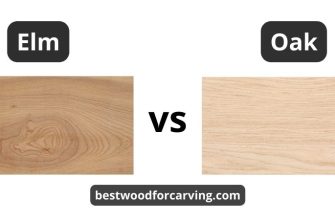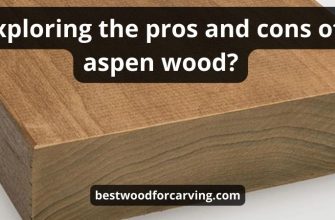Basswood and balsa might be difficult to distinguish. The two types of wood have overlapping uses. Are you planning a woodworking project? Here is what to choose for it.

- Comparative analysis: Balsa vs Basswood
- Appearance
- Durability
- Size and lifespan of trees
- Qualities that resist decay and insects
- Costs
- Sustainability
- Usage
- What can you make out of it?
- Overview of balsa wood
- Balsa wood tree
- Balsa tree pros
- Lightweight wood disadvantages
- Basswood trees overview
- What is good about it?
- Pros against Balsa wood?
- What wood is comparable to basswood?
- FAQ
- Is basswood softer than balsa?
- Which is lighter balsa or basswood?
- Is basswood like balsa wood?
- Final words
Comparative analysis: Balsa vs Basswood
There are several characteristics we will use to see the winner between the two trees.
Appearance
Balsa and basswood resemble one other almost exactly. Although certain kinds seem tan in color, depending on the origin, sapwood, which is often a white to off-white tint, makes up the majority of balsa lumber.
Where it is present, the heartwood is a light reddish-brown color. Sadly, balsa wood trees rarely survive long enough to produce sufficient heartwood.
Similarly, sapwood, which is light brown to pale white, makes up the majority of basswood lumber. Reddish-brown is the rare heartwood color at the moment.
Durability
Basswood is not quite as durable as balsa wood. However, none of these woods are long-lasting. They are suitable for modeling and handicraft to a greater extent.
But they aren’t the best though if you want to construct some furniture.
Especially balsa is easily drawn to insects. Additionally, neither piece of wood can withstand rotting. If you like, you can get rid of the pests in the woods. However, you have to do it more regularly with balsa and basswood.
Winner: If you have to pick just one, go with balsa. When you paint or glaze it, it holds up a little better than basswood.
Size and lifespan of trees
Balsa trees can reach lengths of 18 to 28 meters (65 feet). Additionally, it lives for 30 to 40 years.
Basswood trees, on the other hand, can reach lengths of 20–37 meters (65-121 feet). Additionally, they have a 150-year lifespan.
Qualities that resist decay and insects
Basswood and balsa are both susceptible to pests and insects. For instance, a recent study from Canada discovered that basswood is vulnerable to over 200 insect assaults. Balsa isn’t any better, regrettably.
Basswood and balsawood are both susceptible to rot, deterioration, and dampness. To keep out moisture and delay early decomposition, they both require intensive treatment.
Basswood, however, outperforms wood in all three categories by a small margin. It withstands water, rot, and decomposition a little better.
Costs
Basswood is more expensive than balsa. But I’m not referring to balsa wood of the “A” grade. Balsa wood of “A” quality is highly pricey ($60 per square foot). Even so, basswood is inexpensive (varies from $4 to $7). But I take it that you primarily use these woods for crafting. Therefore, it is always preferable to buy more wood for the same money.
Though significantly more reasonable than you might expect, basswood is nonetheless more pricey. The cost per board foot is approximately $6.99. Pinewood, in contrast, is roughly $2 per board foot.
Winner: No wood is particularly resilient. So there is no need to enlarge it for basswood if you are on a tight budget. Unless there is another noteworthy trait, like bending capacity.
Sustainability
Balsa and basswood are both very sustainable wood kinds.
They first develop and spread organically. Both types of trees are rarely planted for their timber.
Second, both trees grow fairly quickly. As an illustration, we have seen that balsa trees can be harvested in as little as six years.
Basswood has a growth rate of 1-3 feet per year and is just as quick-growing. The trees are hence frequently ready for harvesting in 8 to 10 years.
Above all, balsa and basswood are found beneath thousands of acres of forest, making it unlikely that either wood species will go extinct.
Usage
Basswood and balsa are both good for curving because they are both softwoods and lightweight.
Acoustic guitars are famous for being made by Basswood. Additionally, it is used to create plywood, veneers, wooden blinds, and window shutters. Even wood pulp can be created with it.
Basswood has an excellent capacity for curves. Making designer furniture is therefore also a common practice with it.
What can you make out of it?
Basswood weighs more than balsa wood. So, creating aircraft models is the most common application for it. Additionally, architects utilize it to create model bridges and structures. Balsa wood can also be used to create musical instruments, rafts, buoys, and other items.
Additionally, balsa wood is a superb insulator due to its porosity. As a result, it is used on walls that are prone to dumping. It protects the wall by absorbing the water.
These woods are all bad choices for building outdoor furniture. because they cannot endure heat, rain, or any other extreme weather conditions.
Overview of balsa wood
Ochroma pyramidale, the plant used to make balsawood, is mostly found in Central and South America. It is very prevalent in Ecuador, where it grows in steep areas between rivers and rainforests.
One of the lightest hardwoods is balsa. It is very strong considering its density, though. As a result, during World War One, its wood was first a widely used cork substitute.
Later on, though, it turned out to be a clever material for lightweight shipping containers and gliders.
Between six and 10 years following germination, balsa trees are suitable for harvest. The heartwood of trees older than ten years frequently rot, rendering the outer layers unusable.
Balsa wood tree
It is a type of wood hard enough, though softer than alder wood. The color of Balsa wood is more of a reddish brown. Balsa tree grows in some places only that is why due to climate it is more softwood than hardwood.
Large pores that are not arranged in any particular pattern and fuzzy growth rings are other characteristics of balsa wood. Balsa is prone to insect infestation and is perishable (low rot resistance). It is, however, very feasible.
Balsa tree pros
Balsa wood is a lightweight wood that makes it good for transportation.
Its high workability makes it a great choice for beginners in wood crafting. It is great for model making.
Skateboards, model airplanes, musical instruments, fishing lures, transport boxes, and core material for sandwich laminations are a few common items made of balsa.
Lightweight wood disadvantages
Despite it being convenient to craft using Balsa wood, it is not resistant to water or fire. Be careful not to keep it next to these things. Wings and other parts for model aircraft that is light enough to fly are fashioned from lightweight wood.
Basswood trees overview
Being common in North America and Europe, these trees are quite dominating as they do not require a lot of watering and they can hybridize quickly. Balsa vs basswood comparison showed that the latter ones are quite tall (almost 131 feet tall).
What is good about it?
Let’s see the appearance Basswood trees have. They are light brown or even pale white. Compared to Balsa wood the texture here is more even.
However, this type goes to softwood among all hardwood completely.
Additionally, it has a low density of 915 pounds per cubic foot, which again places it at the bottom end of the hardwood spectrum.
The low-density, soft wood is workable though. It adheres to glue incredibly well and accepts screws and nails quite well. Additionally, compared to other hardwoods, basswood is easier to sand, stain, and paint.
Pros against Balsa wood?
The same degree of working with this soft wood. During the work you will not smell the odor, it has smooth surfaces and you will not need a lot of money to buy it. Balsa wood pros overweigh in here as Basswood shortly rots and is not water or pest resistant.
Basswood is frequently used for tiny woodworking projects, musical instruments (electric guitar bodies), boxes, wood pulp, veneers, plywood, fiber goods, molding, and crates.
What wood is comparable to basswood?
Alder wood is another type of soft hardwood used to make furniture, cabinets, and other woodworking products, much like basswood. A rich supply of protein and some alder species may be palatable.
Alder is better suited for indoor use and is not used for any outdoor applications involving dampness. It is sandable wood with a warm, unpolished natural color of honey.
All three types of wood—basswood, alder, and balsa—are delicate and soft. For all of these woods to have excellent working qualities.
It can occasionally be challenging to work with because of the knotty and erratic grain pattern, but this is uncommon.
When cutting balsa wood, fuzzy surfaces might be a concern when using a dull cutter.
Another white wood that is very well-liked by woodworkers is aspen. It is still pretty soft but is stronger than basswood, making it easier to carve than basswood. Aspen is affordable and widely available.

FAQ
Is basswood softer than balsa?
If you’ve never worked with wood before, start with balsa or both basswood.
Although officially a hardwood, basswood is softer than most of them and is therefore easier to work with. Basswood has so many applications that it is a wise choice for complex projects. But balsa is even softer than basswood to model aircraft or musical instruments.
Which is lighter balsa or basswood?
Due to its lesser weight and greater porosity, balsa is lighter than basswood. Aspen, birch, and white pine are among other woods that resemble basswood and are occasionally used.
Is basswood like balsa wood?
Basswood is soft and light wood with low rot resistance properties, similar to balsa. Basswood, however, is categorized as a hardwood. It has nothing to do with the density of the wood but it has a medium to coarse texture. Despite this, it is stated that basswoods never split or crack.
Final words
Basswood is a little bit more endurance and is less prone to warping than balsa, which is the fundamental distinction between the two materials. The wood pores of basswood are likewise smaller.
So, unlike balsa, it doesn’t quickly absorb moisture. Basswood can maintain its shape and density better than balsa because of this characteristic. Both Balsa and basswood are demanding wood species. Thus, Balsa vs Basswood conclusion for you is simple – you may use any depending desired result and available budget.


![Sapele vs. walnut wood [5 main differences] Sapele Vs. Walnut Wood: Top 5 Differences & Best Guide](https://bestwoodforcarving.com/wp-content/uploads/2024/01/wood-53-335x220.jpg)
![Mango wood furniture pros and cons [9 tips] Mango wood furniture pros and cons + 9 tips before you buy](https://bestwoodforcarving.com/wp-content/uploads/2024/01/wood-51-335x220.jpg)

![Which advantages and disadvantages of hickory wood? [8 factors] Top 8 Disadvantages Of Hickory Wood: Best Helpful Guide](https://bestwoodforcarving.com/wp-content/uploads/2024/01/wood-38-335x220.jpg)


![How Long Do Wood Pellets Last? [6 Essential Insights Unveiled] How long do wood pellets last](https://bestwoodforcarving.com/wp-content/uploads/2023/12/How-Long-Do-Wood-Pellets-Last-6-Essential-Insights-Unveiled-2-335x220.jpg)
![Tung oil vs polyurethane [4 main comparison factors] Tung Oil Vs Polyurethane: Top 4 Factors & Best Helpful Guide](https://bestwoodforcarving.com/wp-content/uploads/2023/12/wood-14-335x220.jpg)
![Is tung oil flammable? [7 Preventive measures] Is Tung Oil Flammable: Top 7 Safe Tips & Best Guide](https://bestwoodforcarving.com/wp-content/uploads/2023/12/What-is-a-Wood-Planer-3-335x220.jpg)